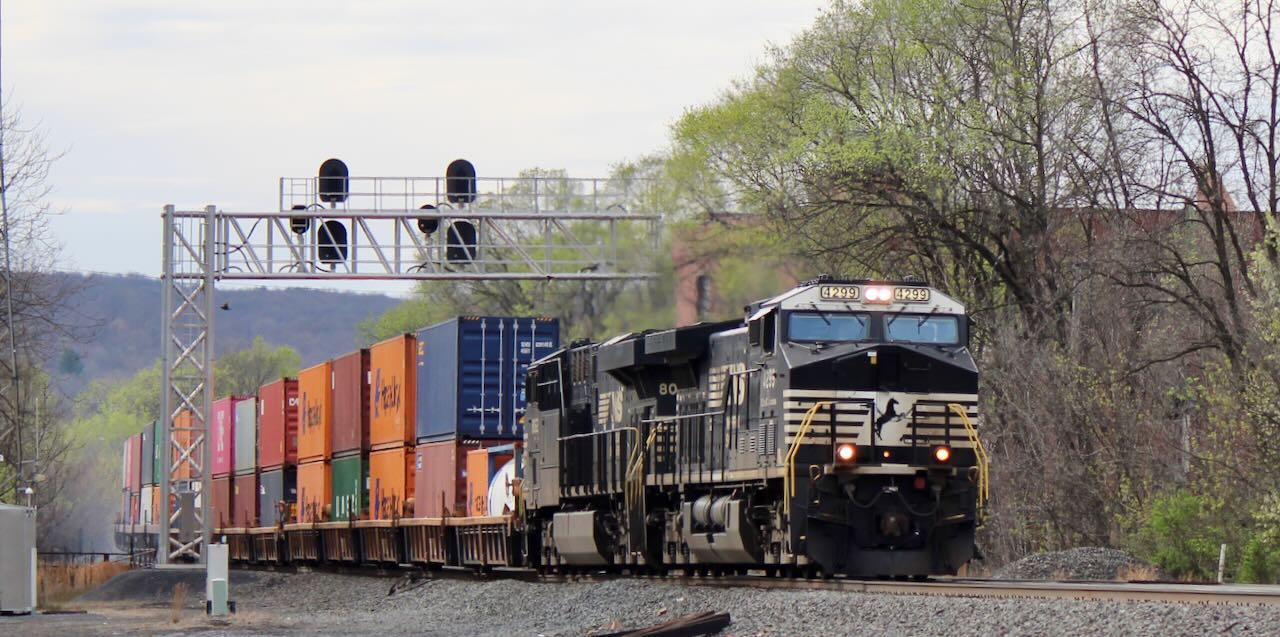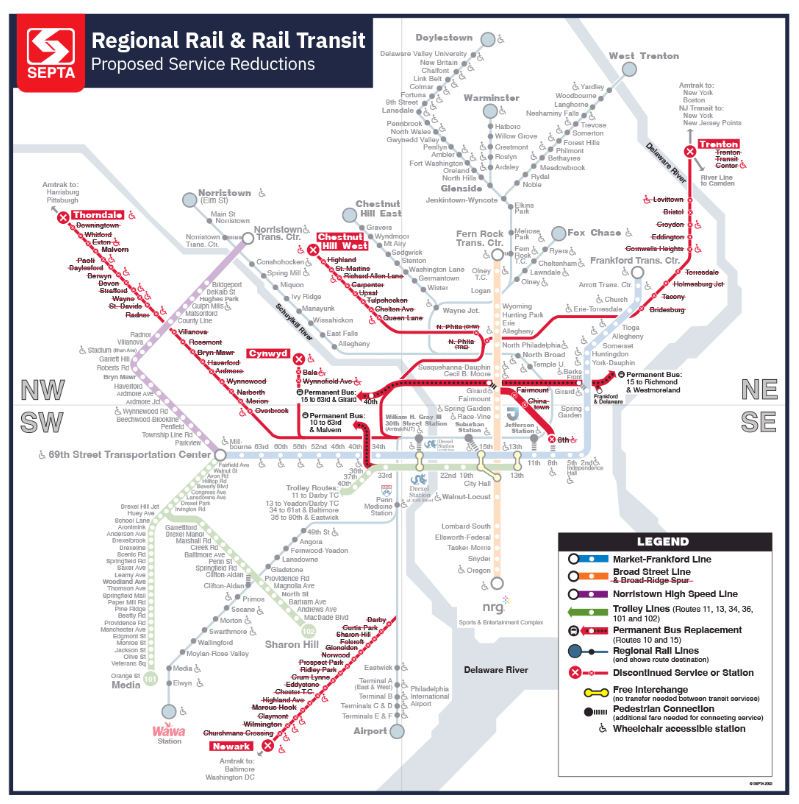
Norfolk Southern and Union Pacific are teaming up to deliver Hapag-Lloyd international containers from the Port of Virginia to destinations on the West Coast.
The new service, said to be a first and dubbed OceaNS Bridge Express, was announced on Wednesday but was launched in April. Importers are struggling with congestion that has caused lengthy delays at the ports of Los Angeles and Long Beach and other West Coast ports.
“We are providing a sustainable and effective coast-to-coast solution to the challenges shippers currently face at West Coast ports,” Shawn Tureman, NS vice president of intermodal and automotive marketing, said in a statement.
“The current environment has led shippers and carriers to think creatively about moving their goods,” Tureman said. “In response, our team took a customer-centric approach by formulating a partnership with Hapag-Lloyd and Union Pacific, providing a new option for shipping to markets in the Western United States.”
The service originates at the Norfolk International Terminal at the Port of Virginia. NS interchanges the traffic with Union Pacific in Chicago, with connections to Seattle, Oakland, and Los Angeles and Long Beach.
“This is an innovative decision by one of our long-time customers to take advantage of our efficiency and our rail reach into the Midwest,” Stephen A. Edwards, CEO and executive director of the Virginia Port Authority, said in a statement. “It’s a unique service, but it is indicative of a very challenging trade environment. We welcomed the opportunity to be part of the solution for cargo owners on the West Coast.”
The service began operating in mid-April with the arrival of the Synergy Antwerp at Norfolk International Terminals. NS hauled nearly 1,000 of the vessel’s containers to Chicago, the port said.
“Union Pacific’s intermodal network is strategically positioned to provide container shippers an alternative with this overland service to the West Coast,” Kari Kirchhoefer, vice president of premium marketing and sales at UP, said in a statement.
The weekly service uses eight Panamax vessels that call at European and Mexican ports before stopping at Houston and Virginia. Last year the Virginia ports handled nearly 2 million containers, 640,000 of which moved inland via rail. NS and CSX both serve the port.
Intermodal analyst Larry Gross says the service makes sense for European trade as well as so-called jump ball cargo that originates in Southeast Asia and could take an all-water route to the West Coast or land on the U.S. East Coast via the Suez Canal.














I should also say that these containers are moving to the west coast and PNW points on UP trains that already exist and not some newly created “express train” for H-L.
As the article says, which probably quotes the presser;
“The new service, said to be a first and dubbed OceaNS Bridge Express, was announced on Wednesday but was launched in April.”
Did anyone in here actually read the article besides Gerald and myself? As much as I disagree with him sometimes, he is the only one who has got it right. Everyone else is looking for a new express train that doesnt exist carrying nothing but H-L containers, NS power leading on the Geneva Sub ( Joe Sieracki, the Geneva Sub never had ATS. They had ATC), and ways to get these new non existent express trains through Chicago. John Rice, you need to take a look at a railroad map. If I read your second comment correctly, you stated the only way get from Colehour to Proviso would be going via the BRC and IHB? Why couldnt this train go from Colehour to Proviso right up the NS mainline to CP 518, and then make a left turn onto the CJ and head via Ashland Avenue yard up to the Rockwell Sub on the UP like all of the other NS interchange trains do? Oh wait, THEY ARE doing just that!
As Gerald stated, this is NOT a new transcontinental through train. The headline of the article makes it sound like it. These containers are moving on EXISTING NS trains coming to Chicago. The train is then handed over to the UP just like it has been and heads to Global 4. The cars are then put on different trains for the LA area, Oakland and Seattle. So as you can see this is NOT a through train in the literal sense, and far from an express. This is really no different than other containers that do the exact same thing right now going from one end of the country to the other.
” John Rice, you need to take a look at a railroad map. If I read your second comment correctly, you stated the only way get from Colehour to Proviso would be going via the BRC and IHB? Why couldnt this train go from Colehour to Proviso right up the NS mainline to CP 518, and then make a left turn onto the CJ and head via Ashland Avenue yard up to the Rockwell Sub on the UP like all of the other NS interchange trains do?”
I did look at a map and tried to translate how a NS through consist would reach UP without using the Rockwell Sub, which is what I interpreted the commenters remarks to mean. I don’t profess to have all knowledge on through trackage rights in greater Chicago, so if there are better means, believe me, I am all ears.
I will look at your remarks and retrace it on the map. Thanks for the update.
Sorry. ATC.
For as long as I’ve been reading TRAINS-MAG — more than half a century — the issue of Chicago bypass has been discussed over and again and never gets fixed. The question I’ve had is this: the Michigan Central, which is a bicycle path. Connected from Porter, Indiana, on the main line of NYC/ PC/ Conrail/ NS, southwesterly then westerly to Joliet. It’s unclear to me how or if it connected to the various railroads in Joliet — Burlington, Rock Island, the “J”, ICRR — anyway, it’s too late now, bicycle paths never revert to railroads.
Because Charles, its not about bypass, its about the cheapest way. Since everyone is in Chicago, it becomes the cheapest place to interchange. All Class 1’s would leave Chicago only if they could all interchange at the same place, the same way.
What I don’t understand is why anyone tries to do a transcon hot shot service, it always has to touch Chicago. The last transcon hotshot I can remember is the one for UPS that didn’t traverse Chicago.
If memory serves it didn’t work out because the 2 Class 1’s involved at the time priced it in the stratosphere. JB Hunt & UPS balked and the service ceased. The Class 1’s justified the pricing because they said the dispatching and track clearances required caused losses or delay in other business and so they had to price it appropriately to compensate.
What happened to the Meridian Speedway? Couldn’t this traffic go that route? I’m not sure of NS routes in Tennessee but could this traffic also go through Roanoke and Bristol?
Yes, the route is cleared for double stacks on the Crescent Corridor. Doesn’t make a whole lot of sense to me either. There are several routes that they could use, but they choose to run straight into a hornets nest. And Seattle in the NW is seemingly the only destination point outside of California.
Creative thinking at NS????? Hah!
All NS to UP comes up through the NS Ashland Yard and has to traverse the Rockwell Sub to reach the UP Geneva Sub line east of Proviso.
This is a very busy line with Metra traffic and constant congestion passing through the Proviso Yard. Every day NS has had a passthrough sitting at Western Avenue waiting for the green signal.
So my question is, why doesn’t NS take the Wabash route at Fort Wayne and go to the interchange at Kansas City and avoid the Chicago terminal completely? UP can still reach all points west from here.
Everyone bellyaches about Chicago congestion but yet here we are trying to push a big square express through a small crowded hole in Chicago. At the same time UP is asking shippers to reduce their private cars, but a low margin container express gets the red carpet.
Make no sense at all.
Length of haul. Also not everything goes ot Ashland. Don’t forget about Colehour Yd. Significant IM steel wheel interchange there.
That would require a pass through the BRC yard and Clearing to reach CP Hill outside Proviso. That would cross 3 active Metra lines instead of just one. Since its an express, I was assuming Ashland Yard as a route marker and crew change location, not necessarily the transfer point to UP.
Really, most European containers do not even come to the West Coast to be unloaded…almost every vessel that is on the West Coast is carrying containers from Asia and the Eastern Pacific. Even going through the Panama Canal it’s more expensive to ship containers all the way from Europe to the West Coast, it’s always been easier to land bridge them via rail…but through Chicago? They’re only using Chicago because the NS already handles container for H-L from NIT, Virginia to Chicago, these are just extra containers that continue on to the West Coast. As for the Mexican traffic, pretty sure the vast majority of that is dropped off in Houston.
Hope this “new’ business doesn’t cause more operational issues on the UP. And that the UP is able to deliver this stack-train to the west coast (relatively) “on-time…”
More NS power leading on the UP West Line out of Chicago.
No more ATS.